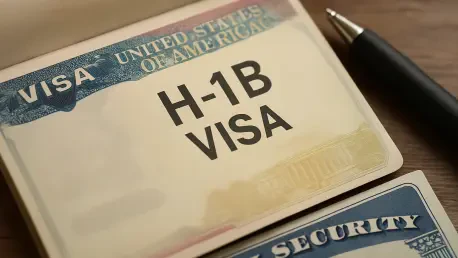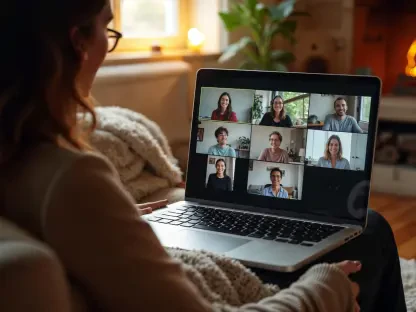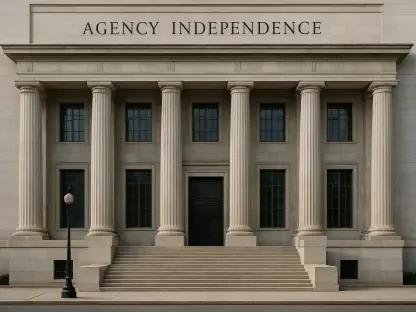As the landscape of U.S. immigration policy continues to shift, few topics generate as much discussion as the H-1B visa program for highly skilled foreign workers. Today, we’re joined by Sofia Khaira, a renowned expert in diversity, equity, and inclusion, who brings a unique perspective on how immigration policies impact talent management and workplace dynamics. With her extensive experience in HR and passion for fostering equitable environments, Sofia offers invaluable insights into the recent changes surrounding the H-1B visa program under President Trump’s administration. In this interview, we’ll explore the implications of the new $100,000 fee for employers, the uncertainties around current visa holders and foreign students, the concept of national interest exceptions, and the broader effects on industries reliant on global talent.
Can you walk us through the core elements of President Trump’s recent H-1B visa proclamation and what it aims to achieve?
Absolutely. The proclamation, issued on September 19, introduced a significant change by imposing a $100,000 fee on H-1B visa petitions, with some exceptions. Alongside this, a proposed rule from the Department of Homeland Security on September 23 aims to prioritize higher-paid roles in the visa lottery system. The overarching goal appears to be restricting the program, which the administration argues has been abused by some employers to suppress wages and disadvantage American workers. It’s framed as a way to protect the domestic labor market, particularly in fields like science and technology, while reshaping how companies access global talent.
How does this $100,000 fee impact employers who rely on the H-1B program to bring in specialized talent?
The fee is a massive financial burden, especially for smaller companies or startups that often depend on H-1B workers to fill niche roles. It’s not just the dollar amount—it’s the uncertainty around when the fee must be paid. The proclamation’s language isn’t clear on whether it’s due upfront with the petition or only after approval, which creates a risky gamble for employers. For many, shelling out $100,000 just to apply, with no guarantee of success, could deter them from even participating in the program, potentially stifling innovation in sectors that thrive on diverse, skilled talent.
How does this proclamation align with the broader immigration policies we’ve seen during Trump’s presidency?
This move fits squarely into the administration’s pattern of tightening both legal and illegal immigration. From day one, there’s been a focus on reducing the inflow of foreign workers, often under the banner of protecting American jobs. The H-1B changes, including this fee and the lottery adjustments, echo earlier actions like travel bans and increased scrutiny of visa applications. It’s a continuation of a narrative that positions foreign labor as a threat rather than a complement to the U.S. workforce, which has consistently sparked debate among employers and advocacy groups.
There was initial panic among employers about how this proclamation might affect current H-1B visa holders. Can you clarify what reassurance was provided?
Yes, employers were understandably alarmed, especially those with H-1B workers traveling abroad. Many feared their employees might be barred from re-entering the U.S. due to the proclamation’s focus on restricting entry. On September 20, the administration clarified that the new rules don’t apply to current H-1B holders, even those outside the country at the time. This was a sigh of relief for companies who had urged their workers to rush back before the effective date of September 21, but it didn’t fully erase all concerns about future ambiguities.
What were some of the specific fears employers had before this clarification came through?
A major worry was for employees on temporary international assignments or personal travel who might get stuck outside the U.S. Tech giants and other firms were particularly concerned about key staff in critical roles being unable to return, disrupting projects and operations. There was also anxiety about how this might signal broader, unannounced restrictions down the line, creating a ripple effect of distrust in the stability of the H-1B program for long-term planning.
Let’s shift to foreign students in the U.S. who often transition to H-1B visas after graduation. How does the proclamation’s language on entry restrictions create uncertainty for them?
The proclamation is explicitly tied to restricting entry into the U.S., based on presidential authority under immigration law. However, many foreign students, especially in STEM fields, are already here on student visas with temporary work authorization. Since they’re not seeking entry from abroad, there’s a big question mark over whether the new rules and fees apply to their H-1B petitions. This gray area leaves both students and their prospective employers in limbo, unsure of the path forward for continuing employment after graduation.
How might this uncertainty affect industries that heavily recruit recent graduates from U.S. universities?
Industries like technology, engineering, and science could take a significant hit. These sectors often rely on fresh talent from universities to drive innovation, and foreign graduates make up a substantial portion of that pool. If employers hesitate to sponsor H-1B visas due to the cost or unclear rules, they might miss out on top talent, or worse, lose them to competitors in other countries. It also risks discouraging international students from choosing U.S. schools in the first place, which could have long-term economic and cultural impacts.
The proclamation includes an exception for industries deemed to be in the ‘national interest.’ Can you unpack what that might mean in this context?
The ‘national interest’ exception is a bit of a puzzle because it’s not clearly defined in the proclamation. It suggests that certain companies or sectors vital to U.S. security or welfare might be exempt from the restrictions and fees. Looking at past precedents, like exceptions during the early COVID-19 pandemic, critical infrastructure areas such as healthcare, energy, and manufacturing were often prioritized. However, it’s anyone’s guess how broadly or narrowly this will be interpreted now, and whether it will extend beyond those traditional sectors.
Given the criticism of STEM and IT sectors in the proclamation, do you think they’re likely to qualify for this national interest exception?
That’s a tough call. On one hand, STEM and IT are undeniably crucial to the U.S. economy and innovation pipeline. On the other, the proclamation specifically calls out these sectors for allegedly exploiting the H-1B program to suppress wages. This contradiction makes it uncertain whether they’ll be granted exemptions, even though their contributions could easily be argued as being in the national interest. It’ll likely depend on how much political pressure and economic data influence the final interpretation.
What is your forecast for the future of the H-1B program under the current administration’s approach to immigration policy?
I anticipate continued restrictions and higher barriers for both employers and foreign workers. The trend points toward a narrower scope for the H-1B program, with more fees, stricter criteria, and possibly even lower annual caps. However, pushback from the business community and potential legal challenges could temper some of these changes. Long term, I think we’re looking at a program that’s much harder to access, which might force companies to rethink their talent strategies—whether that means investing more in domestic training or shifting operations abroad to where skilled workers are more readily available.









